Abstract
1 The effect of morphine on body temperature was studied in conscious, unrestrained cats provided with implanted third or lateral cerebral ventricular cannulae, jugular venous catheters and retroperitoneal thermocouples.
2 Intraventricular injections of 2.5-50 μg and intravenous injections of 1-10 mg/kg morphine sulphate produced dose-related hyperthermic responses. Similar mean increases in body temperature after administration of a given dose were elicited in cats which had not previously received morphine and, provided that tolerance was avoided by spacing injections at least 72 h apart, in cats which received a series of injections of morphine. Morphine was at least 850 times more potent when injected into the third ventricle than when given intravenously. Increasing the dose of morphine sulphate injected into the third ventricle to 1250 μg only prolonged the hyperthermia. Morphine did not produce hypothermia at any dose tested.
3 Injection of 10 μg morphine sulphate into the third ventricle produced similar hyperthermias at ambient temperatures (tas) of 4-6, 21-23 and 33-36°C. The increase in body temperature was associated with shivering at the lower tas. At the highest ta, shivering was not evoked, but respiratory rate decreased after morphine if it was initially elevated. These results suggest that morphine increased the level at which body temperature was regulated.
4 Neither metiamide nor indomethacin antagonized morphine so histamine and prostaglandins were apparently not required for the hyperthermic effect.
Full text
PDF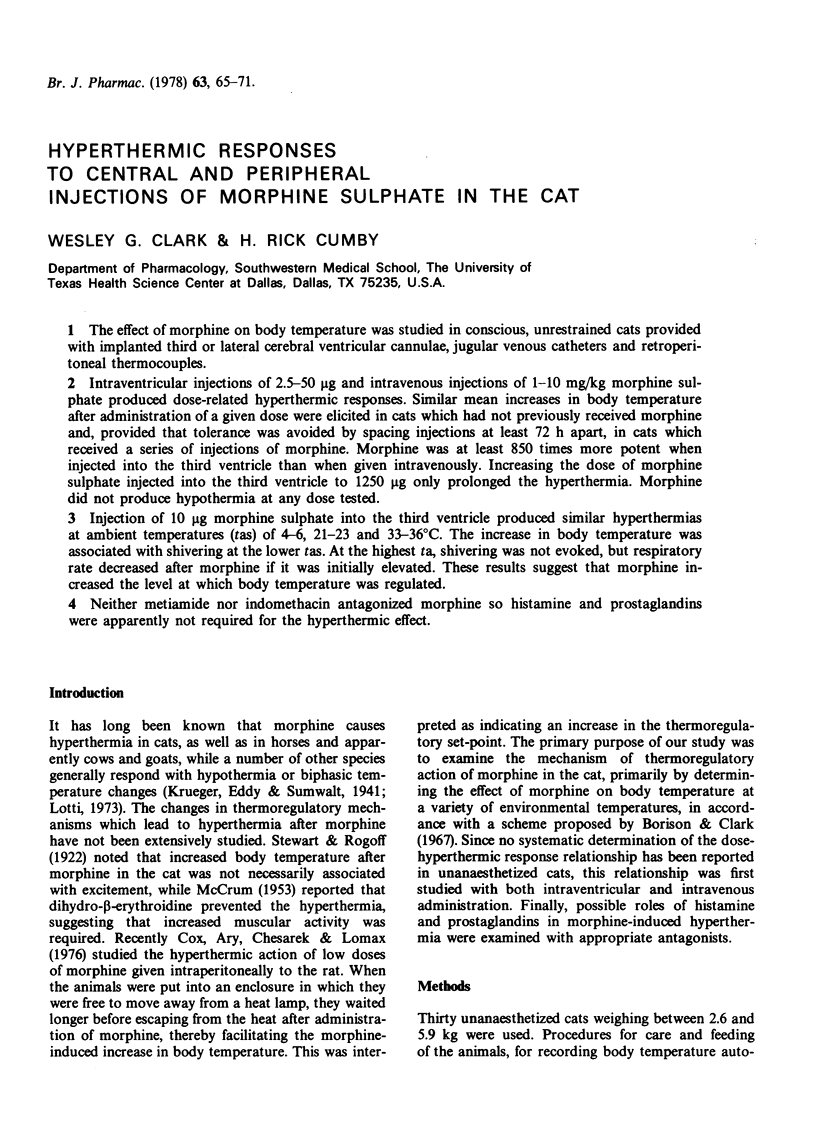

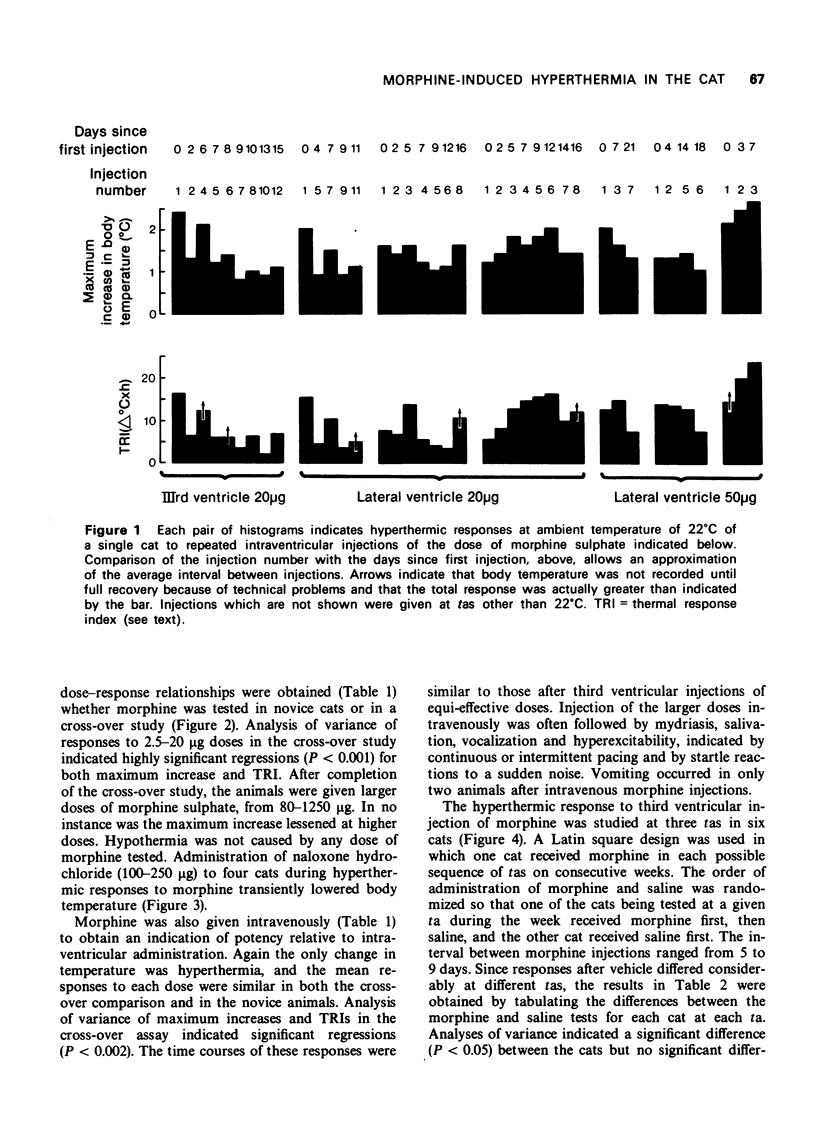
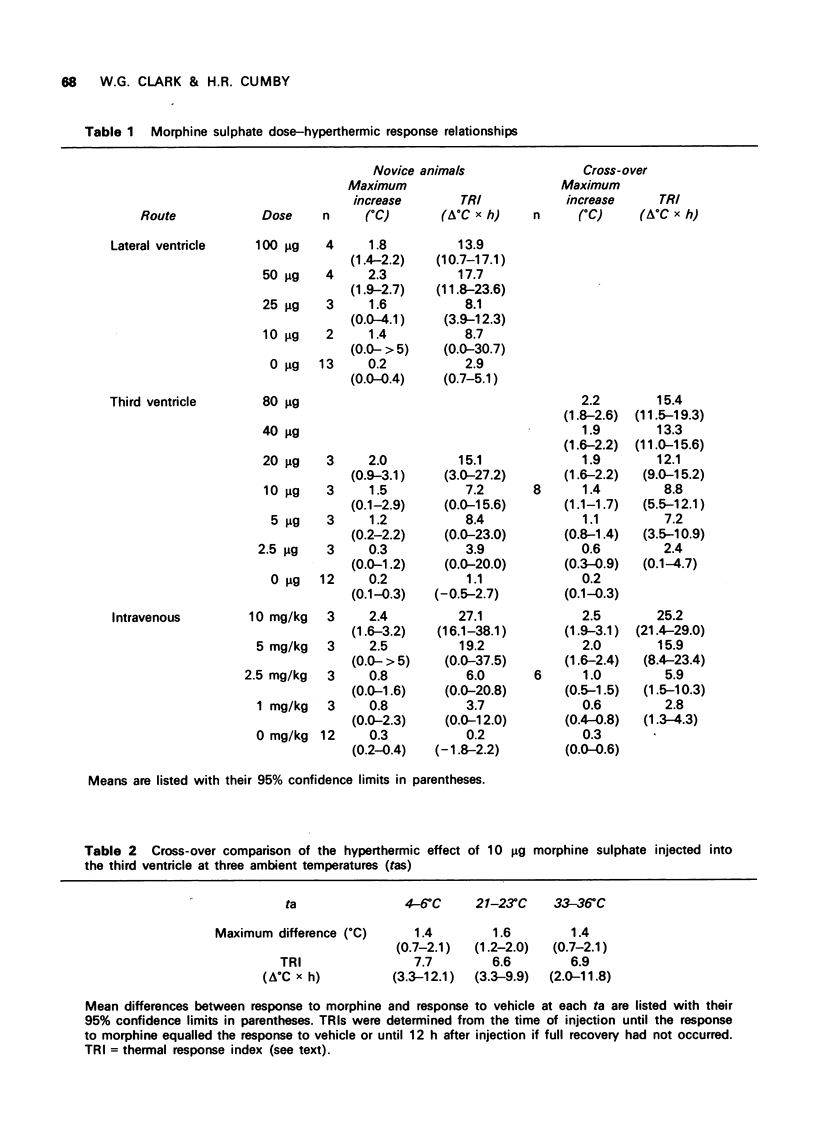
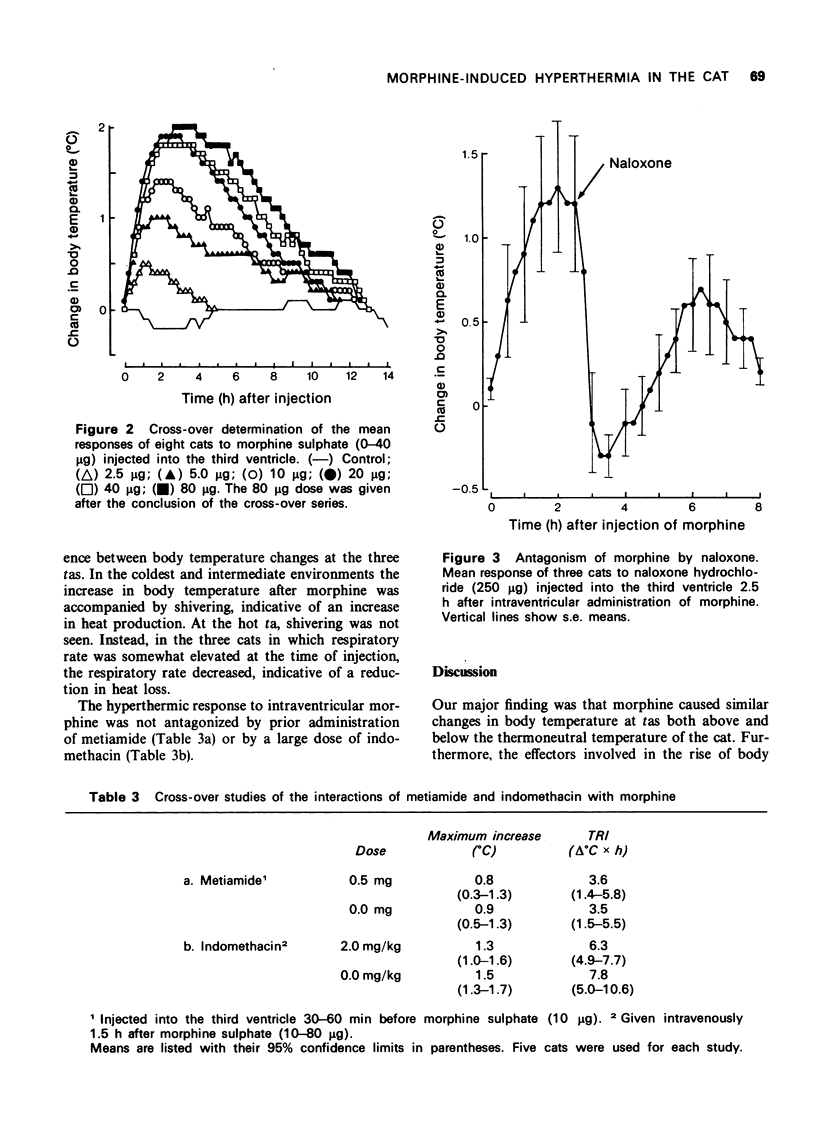
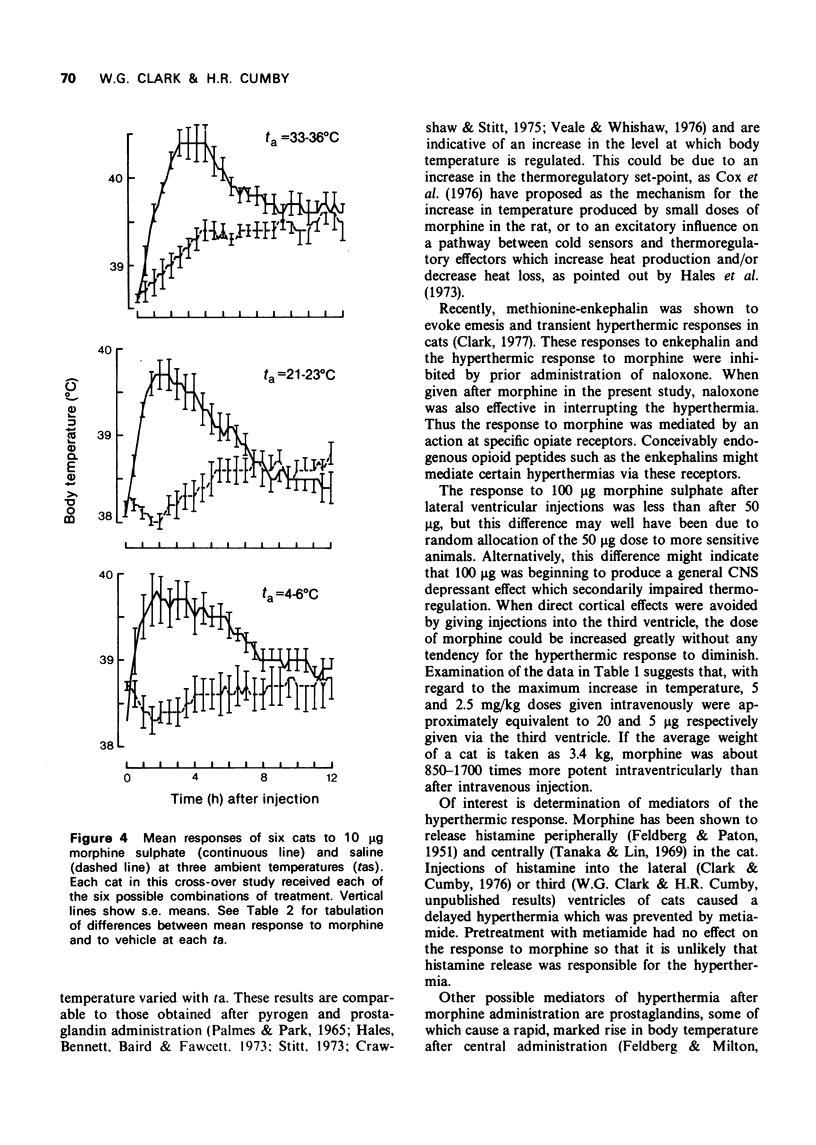
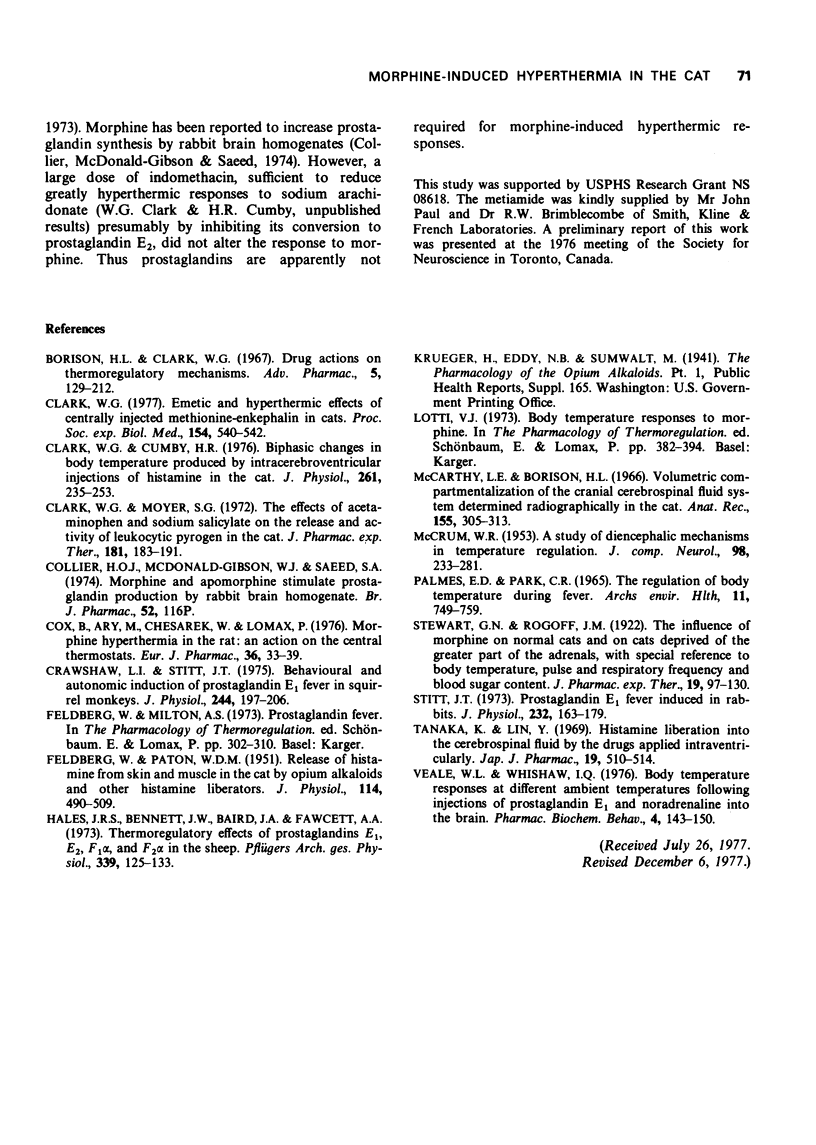
Selected References
These references are in PubMed. This may not be the complete list of references from this article.
- Borison H. L., Clark W. G. Drug actions on thermoregulatory mechanisms. Adv Pharmacol. 1967;5:129–212. doi: 10.1016/s1054-3589(08)60657-2. [DOI] [PubMed] [Google Scholar]
- Clark W. G., Cumby H. R. Biphasic changes in body temperature produced by intracerebroventricular injections of histamine in the cat. J Physiol. 1976 Sep;261(1):235–253. doi: 10.1113/jphysiol.1976.sp011556. [DOI] [PMC free article] [PubMed] [Google Scholar]
- Clark W. G. Emetic and hyperthermic effects of centrally injected methionine-enkephalin in cats. Proc Soc Exp Biol Med. 1977 Apr;154(4):540–542. doi: 10.3181/00379727-154-39713. [DOI] [PubMed] [Google Scholar]
- Clark W. G., Moyer S. G. The effects of acetaminophen and sodium salicylate on the release and activity of leukocytic pyrogen in the cat. J Pharmacol Exp Ther. 1972 Apr;181(1):183–191. [PubMed] [Google Scholar]
- Collier H. O., McDonald-Gibson W. J., Saeed S. A. Proceedings: Morphine and apomorphine stimulate prostaglandin production by rabbit brain homogenate. Br J Pharmacol. 1974 Sep;52(1):116P–116P. [PMC free article] [PubMed] [Google Scholar]
- Cox B., Ary M., Chesarek W., Lomax P. Morphine hyperthermia in the rat: an action on the central thermostats. Eur J Pharmacol. 1976 Mar;36(1):33–39. doi: 10.1016/0014-2999(76)90253-3. [DOI] [PubMed] [Google Scholar]
- Crawshaw L. I., Stitt J. T. Behavioural and autonomic induction of prostaglandin E-1 fever in squirrel monkeys. J Physiol. 1975 Jan;244(1):197–206. doi: 10.1113/jphysiol.1975.sp010791. [DOI] [PMC free article] [PubMed] [Google Scholar]
- FELDBERG W., PATON W. D. M. Release of histamine from skin and muscle in the cat by opium alkaloids and other histamine liberators. J Physiol. 1951 Aug;114(4):490–509. doi: 10.1113/jphysiol.1951.sp004639. [DOI] [PMC free article] [PubMed] [Google Scholar]
- Hales J. R., Bennett J. W., Baird J. A., Fawcett A. A. Thermoregulatory effects of prostaglandins E 1 , E 2 , F 1 and F 2 in the sheep. Pflugers Arch. 1973 Mar 21;339(2):125–133. doi: 10.1007/BF00587179. [DOI] [PubMed] [Google Scholar]
- MCCRUM W. R. A study of diencephalic mechanisms in temperature regulation. J Comp Neurol. 1953 Apr;98(2):233–281. doi: 10.1002/cne.900980204. [DOI] [PubMed] [Google Scholar]
- McCarthy L. E., Borison H. L. Volumetric compartmentalization of the cranial cerebrospinal fluid system determined radiographically in the cat. Anat Rec. 1966 Jul;155(3):305–313. doi: 10.1002/ar.1091550304. [DOI] [PubMed] [Google Scholar]
- Palmes E. D., Park C. R. The regulation of body temperature during fever. Arch Environ Health. 1965 Dec;11(6):749–759. doi: 10.1080/00039896.1965.10664295. [DOI] [PubMed] [Google Scholar]
- Stitt J. T. Prosaglandin E1 fever induced in rabbits. J Physiol. 1973 Jul;232(1):163–179. doi: 10.1113/jphysiol.1973.sp010262. [DOI] [PMC free article] [PubMed] [Google Scholar]
- Tanaka K., Lin Y. Histamine liberation into the cerebrospinal fluid by the drugs applied intraventricularly. Jpn J Pharmacol. 1969 Dec;19(4):510–514. doi: 10.1254/jjp.19.510. [DOI] [PubMed] [Google Scholar]
- Veale W. L., Whishaw I. Q. Body temperature responses at different ambient temperatures following injections of prostaglandin E1 and noradrenaline into the brain. Pharmacol Biochem Behav. 1976 Feb;4(2):143–150. doi: 10.1016/0091-3057(76)90006-x. [DOI] [PubMed] [Google Scholar]


